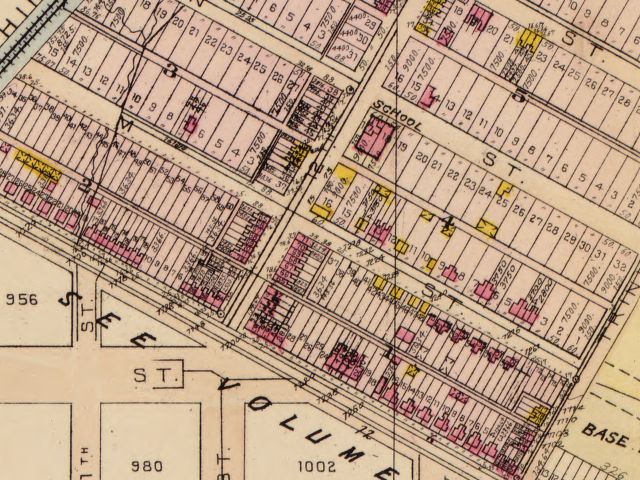In celebration of Black History Month, we’re going to feature the history of DC’s African American neighborhoods because DC history is DCPS history. The vitality of our schools is irrevocably tied to the neighborhoods it serves.
Park View

Park View was established in 1908 when several smaller neighborhoods were combined and is bounded by Gresham Street to the south, Rock Creek Church Road the north, and extends from Georgia Avenue east to the U.S. Soldiers' and Airmens' Home grounds. The neighborhood quickly became known for amateur baseball in the District, winning the short-lived Suburban League's pennant in 1909.1
The “park” in Park View refers to the nearby grounds of the U.S. Soldiers' and Airmens' Home, which used to be open to the public as a space comparable to New York City’s Central Park.2

Soldiers’ Home Cattle and Dairy Farm in 19493
Park View School was constructed in 1915-1916 after years of lobbying by the Park View Citizens Association. Municipal Architect Snowden Ashford designed Park View in the Collegiate Gothic style, and it remains an almost perfect example of this style of Washington architecture. The Park View was also the first elementary school in DC to have its own dedicated auditorium. The Historic Preservation Review Board called it a "superior specimen of the public elementary school" on May 24, 2012 as it designated the Park View School a D.C. historic site. The school was also recently modernized and much of the historic architectural features were preserved.
By 1949 Park View Elementary, with a capacity of 936 students, had an enrollment of only 128. In the District’s segregated school system Park View—located amid an increasingly African American community—served only white children. Despite resistance from white residents, Park View was transferred to the DC Public Schools’ “colored division” in July 1949.

U.S. Attorney General Robert F. Kennedy visiting the school in 1963.3
Around 1950, the originally all-white Park View neighborhood became majority African American, due to the proximity of Howard University and to the 1948 Supreme Court ruling that made restrictive housing covenants unenforceable.
Today, Parkview is diverse neighborhood with a strong sense of community among its residents. As retail grows along Georgia Avenue and home prices remain reasonable, the area will continue to be a draw for years to come.2
Special thanks to ANC 1A08 Commissioner Kent Boese for providing the vast majority of the historical information for Parkview. Read excerpts from Boese and Laura Hafvenstein's book, Images of America: Park View
Sources:
1.Ann Cameron Siega (May 1, 2010). Park View neighborhood in District is pleasantly walkable. Washington Post. Retrieved from http://www.washingtonpost.com/wp-dyn/content/article/2010/04/30/AR2010043000029.html?sid=ST2010043001856
2. Dena Levitz (August 3, 2012). Park View: It’s Not Petworth. Retrieved from http://dc.urbanturf.com/articles/blog/park_view_its_not_petworth/5851
3. Source: Humanities Council of DC - wdchumanities.org
Learn more about Parkview:
- Parkview DC - Parkviewdc.wordpress.com
- Park View: It’s Not Petworth - dc.urbanturf.com
- Historic Parkview Walking Tour - wdchumanities.org
Trinidad

In our first installment, we’re highlighting the Northeast neighborhood known as Trinidad. Trinidad is bounded to the north by Mt. Olivet Road, to the west by West Virginia Avenue, to the south by Florida Avenue, and to the east by Bladensburg Road.
Trinidad is named after the island nation that James Barry lived in for a period of time. Barry was a nineteenth century land speculator, who originally owned the parcel of land north of Boundary Road (Florida Ave). Barry also owned a large parcel of land east of the river called Barry Farms that enveloped much of modern day Ward 8.
The land passed through several owners before landing into the possession of the Washington Brick Machine Company that excavated the rich clay soil for brick production. Those very same bricks would be used to build the first subdivisions on the western part of Trinidad.
For this series, we’re relying on some of the awesome community blogs and neighborhood organizations that have already researched this neighborhoods’ history.
Did you know?
- Wheatley Education Campus sits on the same land as the original Trinidad School at corner of Montello Ave NE and Neal St. NE.

1903 Baist real estate atlas of Washington – Trinidad neighborhood (Library of Congress) Photo courtesy of GhostsofDC.org. (ghostsofdc.org/2012/05/21/officer-sprinkle-trinidad/)
- Trinidad was home to the Washington Senators from 1901-1902. They played at the American League Baseball Park located at the corner of Trinidad Avenue and Florida Avenue.

Photo Courtesy of the Trinidad Neighborhood Association. trinidadneighborhood.org/about/history/
- Trinidad was once home to a car barn at 15th and H Streets, NE. It was originally built in 1895 to replace a horse-car barn. Horses first powered the original streetcars. They were later powered for a few years by cables, before finally electric power took hold.

Photo courtesy of Greater Greater Washington (greatergreaterwashington.org/post/4002/lost-washington-trinidad-car-barn/)
Learn more about Trinidad:
- Investigating Where We Live - Investigating Where We Live (IWWL) is a summer outreach program at the National Building Museum, designed for students aged 12-16 from the D.C. metropolitan area.
- Frozen Tropics – Neighborhood blog started by Trinidad Resident, Elise Bernard.
- Titan of Trinidad – Neighborhood blog started by an anonymous Trinidad resident.
Learn about the great Americans for which our schools are named »


